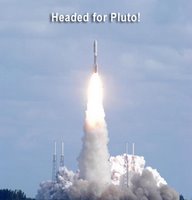 This has been a busy Space week. In addition to last Sunday's safe landing of the Stardust capsule(link), on Thursday NASA launched the first probe bound for the planet Pluto and beyond.
This has been a busy Space week. In addition to last Sunday's safe landing of the Stardust capsule(link), on Thursday NASA launched the first probe bound for the planet Pluto and beyond.The probe is on a nine-year trek towards Pluto. The spacecraft should swing past Jupiter, grabbing a gravity boost in the process, in late February 2007.
Pluto is the only member of the traditional nine-planet solar system not visited by a spacecraft, a statistic New Horizons hopes to change. The probe carries seven primary instruments to study Pluto, its moon Charon and two other objects – currently dubbed P1 and P2 – discovered orbiting the planet last year.
 The spacecraft is designed to begin observing Pluto about five months before its scheduled flyby in July 2015, which will take place about three billion miles from Earth .
The spacecraft is designed to begin observing Pluto about five months before its scheduled flyby in July 2015, which will take place about three billion miles from Earth .Mission managers expect New Horizons to speed past the planet at about 31,000 miles per hour while using its instrument package to build detailed maps of the planet, as well as study its composition and tenuous atmosphere.
About nine months after the encounter, the 1,054-pound spacecraft should finish sending its Pluto observations to Earth, which will take about 4.5 hours to reach researchers on the ground.
The information New Horizons will send to Earth about Pluto and its moons will likely alter our view of the distant, icy world, researchers said.
NASA's New Horizons Page(link)
New Horizons Trivia
A Lockheed Martin-built Atlas 5 rocket flung the New Horizons spacecraft away from Earth at about 36,250 miles per hour– the fastest ever for a NASA mission
Riding aboard the NASA spacecraft are ashes of the late astronomer Clyde Tombaugh, who discovered the planet in 1930 at the Lowell Observatory in Flagstaff, Arizona. Tombaugh died in Jan. 17, 1997.
A Florida quarter – bearing the image of a space shuttle – is also accompanying the probe to Pluto.
No comments:
Post a Comment